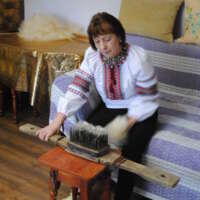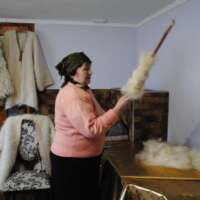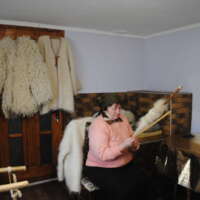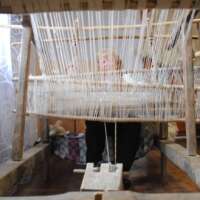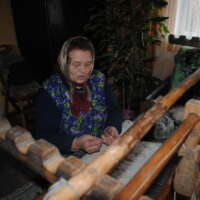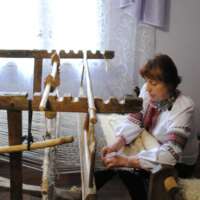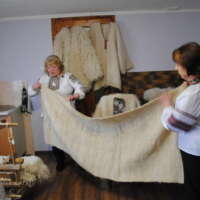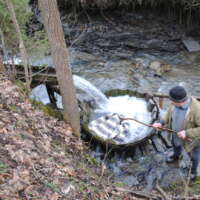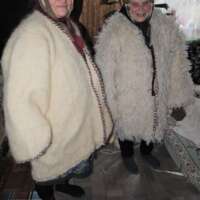- Home
- Elements ICH
- Hutsulska bryndza
- Wool weaving in Hutsulschyna
- Iza wickerwork
- Lysychovo blacksmith tradition
- Weaving tradition
- Hunia of Richka
- Аrtistic Weaving
- Folk music tradition
- Boronyavo Sharkhan
- Betlehem in Choma
- Measure in Yasinia
- Mayalish in Storozhnytsia
- Petrivska Subitka
- Kolochavska Riplyanka
- Slyvovytsia of Novoselytsia
- Bychkiv Honey Cake
- Transcarpathian Bograch
- Plum Lekvar (jam)
- Transcarpathian Shovdar
- Online Lectures
- Master Classes
- Methodical Recommendations
- Catalogs
Communal Institution «Regional Organizational and Methodical Center of Culture» of Zakarpattia Oblast Council
Then, the process of weaving takes place using an ancient ‘krosna’ – a horizontal loom. The last step is to treat the fabric with water in a ‘valylo’ – a special structure on a mountain stream.
There are two types of hunias. Simple, felted ones with a natural pile and kots ones with a long woven woolen strand let out, so that neither rain nor snow soaks them completely. Hunia ‘kotsovania‘ is woven in the same way as felted boots, but woolen threads are woven in.
Today, only a few mountain villages in Zakarpattia produce hunias by hand. This craft is best preserved in the village of Richka in the Pylypets community. It is here that craftswomen live who still master the ancient art of making hunias. They sew them using authentic raw materials produced in their region.
The weaving of hunias distinguishes the village from others and makes it attractive to tourists, which in turn contributes to the development of green tourism, increases the economic capacity of the community and creates new financial opportunities for the local population.
The original type of weaving that has been preserved in Richka is closely related to the Transcarpathian traditions of making handicrafts and is, in fact, one of them. At the same time, the production of hunias organically fits into the economic way of life of the local population. The wool used to make them is the wool that the locals get from their own sheep. This is how they support sheep farming in the region.
The preservation of this unique craft has become an important factor in promoting increased interest in this village, and the tradition itself has transformed into a kind of business card for the Richka.
The project was implemented with the support of the Ukrainian Cultural Foundation
Online HUB ICH of Transcarpathia , 2019

he traditional clothing of the inhabitants of the mountainous regions of Transcarpathia, both men and women, has long been the hunia. Until the middle of the twentieth century, it was hard to imagine Verkhovyna residents without this authentic outerwear at any time of the year.
Men’s hunias were mostly long, up to the knees. Women’s were shorter, up to the middle of the thighs or below the waist.
As a rule, a family had up to ten hunias – festive and everyday. The white ones were worn to church and for weddings. Black and grey ones were worn on weekdays and for funerals.
Hunias in Transcarpathia have long served as amulets. They were a constant attribute of the wedding ceremony, they were thrown under the feet of the newlyweds and ‘danced’ during the wedding – ‘to make them happy, to make them rich’.
On Christmas Eve, when the owner brought hay into the house, the hostess would lay a hunia outside the doorway in the hayloft so that her husband would not step on bare ground, so that in the New Year they would live in warmth and goodness, and so that they would have good harvests.
When a ‘khyzha’ (hut) was being built, when the walls were built and the rafters were laid, the master would put on a hunia and say: ‘So that this khyzha does not leak, until the end of time, so that the rain and snow slide off the house like a hunia…’.
The raw material for hunia is sheep’s wool. The animals are sheared every spring, then the steamed, washed and dried wool is ‘chyhraty’ (combed) on special brushes, and then ‘krosna’ (woven) – the thread is twisted on a kudela and spindle, and the warp is woven on a snivanets.



Richka is a village in the Mizhhirya Rayon of the Pylypets territorial community (now Khust district) in Zakarpattia.
Population: about 850 inhabitants.
Coordinates: 48° 35′ 19″N, 23° 22′ 27″E.
Distances: Kyiv – 730 km, Lviv – 189 km, Uzhhorod – 136 km.
The first mention is from 1600 under the name Rychke, other mentions: 1646 – Riczka, 1715, 1725 and 1773 – Ricska, 1808 – Ricska, Rička, Ryčka, 1828 – Ricska, 1913 – Kispatak, 1925 – Rička, 1944 – Ricska, 1983 – Rika.
In 1715, the village was mentioned under the Hungarian name Kish-potok, i.e. Small Stream.
Read more: https://uk.wikipedia.org/wiki/Річка_(Хустський_район)
